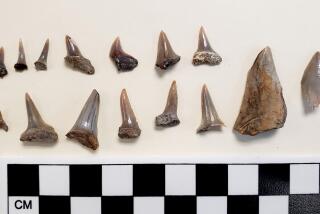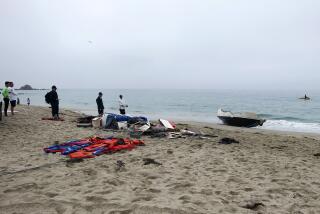Floating an Old Idea
- Share via
Mike Macko painstakingly gathered tule reeds by the hundreds, pulling them out of mud in the San Joaquin freshwater marsh in Irvine. He dried and stored them. Then he bundled them together and tied the bundles to create a boat the likes of which California has not seen for hundreds of years.
Then he presented it as a gift to Orange County’s Juaneno Band of Mission Indians--transporting it in a thoroughly 1990s kind of way.
“This is a fantastic gift,” said David Belardes, Juaneno tribal chief. “You should have seen it strapped on top of Mike’s Chevy Suburban when he brought this in--it was like, ‘Here comes Thor Heyerdahl.’ ”
But Macko’s dream didn’t end there. The 45-year-old Huntington Beach archeological consultant now hopes to put that reed boat into the forbidding waters of the Pacific Ocean to test a theory that the first humans on the coast came by sea some 10,000 years ago.
Macko--an anthropologist who does work for Orange County government and the Irvine Co.--copied a boat-making technique used hundreds of years ago by West Coast Native Americans as part of a personal quest that stems from a long-standing fascination with sailing and history.
“I always loved the ocean,” said Macko, who graduated from the U.S. Naval Academy in Annapolis, Md., and earned a master’s degree in anthropology at UC Santa Barbara. “And, I’ve been a Kon Tiki fan. So when I started anthropology in graduate school, I began wondering about the Indians’ use of watercraft and what it might be [like] to build one.”
It’s not the first time Macko has been in the limelight. In 1997, he oversaw an Irvine Co. excavation that was severely criticized by some for removing the remains of 600 or more prehistoric people to make room for 149 luxury homes.
Far less controversial, his boat project has stretched over several years, counting two efforts that failed. The earlier boats fell apart, Macko said, because he hadn’t mastered the knack of tying reeds.
Measuring 19 feet long by 4 feet wide and weighing 300 pounds, his latest effort took him nearly three weeks to build. He sought to replicate the kind of vessel that coastal Indians--such as the Chumash in Santa Barbara and Ventura counties, and Orange County’s Juanenos--used before the arrival of European settlers.
Macko used historical photos and advice from Santa Barbara Chumash as a guide. Belardes joked that it wasn’t like buying a kit at some boat shop.
But “once I had the right advice, they’re very easy to make,” Macko said.
Tying the bundles together was the most time-consuming part of the job. He then used an asphalt material--a substitute for the tar the early Indians may have used--to serve as a binding agent that he painted over twine.
He describes the boat, capable of carrying two or three people, as “very buoyant,” a judgment affirmed by a recent brief test in Upper Newport Bay.
The real test will come soon, he hopes, when Macko hopes to sail the boat--or another like it that he’s building--from the Palos Verdes Peninsula to Santa Catalina Island. The proposed trip is expected to take the better part of a day because there is no sail: Along with members of the Juaneno band who will help with the test, Macko will use a flat-sided paddle such as those used by the Hawaiians.
“I think with at least two people constantly paddling, we can do it in about eight, maybe 10 hours,” Macko said.
A fan of Heyerdahl’s famous Kon Tiki voyage of 1947, Macko said he was challenged by the idea that tribal ancestors had a flourishing economy thousands of years ago that took them island hopping on similar craft.
The anthropologist says the boat also serves as a study tool. He is anxious to learn how long it will float and the effects of different ropes and binding materials.
Among the bigger questions: Did the first humans to arrive in California about 10,000 years ago come by sea or by land, over the desert? Although there is more evidence to suggest travel by land, “clearly they were marine-based when they first got here,” he said.
Macko’s gift of the boat has sent ripples of pride among Juanenos, who historically have been more tied to inland Northern San Diego County tribes than to the Chumash in the north.
Last month, a Washington tribe gained national headlines for a whale hunt in a carved cedar canoe built on ancient models. Belardes acknowledged that such hunts under the banner of reviving old tribal customs sometimes stir controversy, but he said a proposed trip to Catalina in Macko’s boat is tame by comparison.
Significantly, Belardes said the boat adds more proof that Juanenos not only survived on the land by eating grasses and wildlife, but also fished the region’s waterways.
“You know, there’s only a handful of books about the Juanenos,” Belardes said. “But in our language we do have words such as wixet, for boat, and palut for paddle. That’s plenty of proof right there.”
The boat will be on display at the Blas Aguilar Adobe in San Juan Capistrano, a 202-year-old structure that also serves as a Juaneno museum.
(BEGIN TEXT OF INFOBOX / INFOGRAPHIC)
Back in Time
Using ancient techniques once employed by Southern California Indians, anthropologist Mike Macko built a canoe out of hundreds of reeds, twine and tar. To test the boat’s seaworthiness, Macko plans to row the canoe from the Palos Verdes Peninsula to Santa Catalina Island. How the boat was built:
1. Cut, dry and pile reeds
2. Tie pile in tight bundle
3. Flatten bundle with cross ties
4. Bind side bundles to bottom
By the Numbers
Length: 19 feet
Width: 4 feet
Weight: 250 pounds
Capacity: 1,000 pounds
Rowing speed: 3 knots (about 3.5 mph)
Source: Boat-builder Mike Macko
More to Read
Sign up for The Wild
We’ll help you find the best places to hike, bike and run, as well as the perfect silent spots for meditation and yoga.
You may occasionally receive promotional content from the Los Angeles Times.






